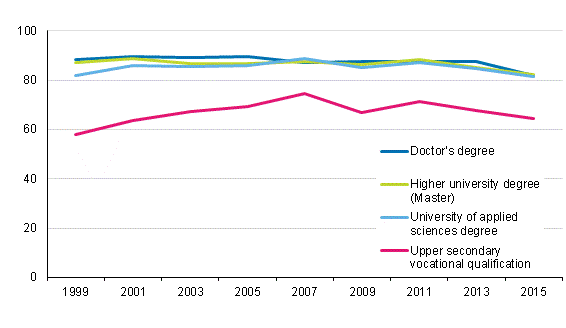Published: 26 January 2017
Employment of recent graduates weakened further
According to Statistics Finland's education statistics, employment of recent graduates continued weakening in 2015. Employment has weakened already for five years and is currently at a lower level than during the previous downturn. Among those with qualifications from upper secondary vocational education 65 per cent were employed and among those with higher university degrees 80 per cent.
Employment of graduates one year after graduation 1998–2015, %

Employment among recent graduates is measured one year after their graduation. Sixty-five per cent of all graduates were working, which is one percentage point lower than in the year before. In total, 50 per cent of graduates were working full-time and 15 per cent were working besides studies in 2015. The proportion of the unemployed was 14 per cent.
Among those with qualifications from upper secondary vocational education 65 per cent were employed, of whom nearly ten per cent were working besides studies. Every fifth of those with qualifications from upper secondary vocational education were unemployed after graduation. Altogether, 82 per cent of those with university of applied sciences degrees and higher university degrees were employed. While the unemployment of all recent graduates increased by one-half of a percentage point, that of both graduates with higher university degrees and doctorate degrees increased by over one percentage point. Every tenth of those having completed a higher university degree and a university of applied sciences degree were unemployed. Employment of doctors weakened by close on two percentage points from the previous year. Of recently graduated doctors, 82 per cent were employed and eight per cent were unemployed.
Compared to the year before, transition to work by both men and women weakened somewhat. Of men, 59 per cent had found employment and of women 70 per cent. Employment of men graduating from vocational education was particularly difficult. In 2015, 58 per cent of men with vocation qualifications and 71 per cent of women were working. These shares were 79 per cent for men and 83 per cent for women among those with university of applied sciences degrees. Men and women with higher university degrees found employment almost equally easily. Of men, 83 per cent were employed and of women 82 per cent. Women with doctorate degrees were employed five percentage points better than men. Of them, 85 per cent were employed.
The majority of those having completed the matriculation examination and a lower university degree continue studying in other education, 61 per cent of passers of the matriculation examination and 87 per cent of completers of lower university degrees. More information related to direct transition to further studies of passers of the matriculation examination is available from the statistics on Entrance to education .
There were differences in the transition to working life by field of education. The transition was easiest for those with qualifications from the field of health and welfare, of which 84 per cent of graduates were employed. Those with degrees in education were employed nearly as easily. Eighty-one per cent of graduates in education were employed. At 23 per cent, the number of unemployed was highest in the field of technology. More detailed data on the employment of recent graduates by level and field of education can be found in the database tables .
Examined by region, the rate of employment among recent graduates varied from 82 per cent in Åland to 56 per cent in North Karelia. Besides Åland, the rate of employment was higher than the average for the whole country in the regions of Uusimaa, Kanta-Häme, Central Ostrobothnia and Ostrobothnia.
Source: Education 2017. Statistics Finland
Inquiries: Anna Loukkola 029 551 3678, koulutustilastot@stat.fi
Director in charge: Jari Tarkoma
Publication in pdf-format (212.1 kB)
- Tables
-
Tables in databases
Pick the data you need into tables, view the data as graphs, or download the data for your use.
Appendix tables
Updated 26.1.2017
Official Statistics of Finland (OSF):
Transition from school to further education and work [e-publication].
ISSN=1798-9469. 2015. Helsinki: Statistics Finland [referred: 21.12.2025].
Access method: http://stat.fi/til/sijk/2015/sijk_2015_2017-01-26_tie_001_en.html

